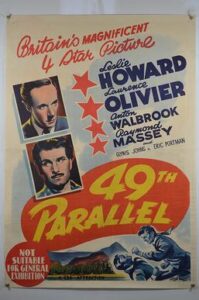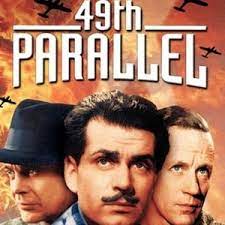The second film discussed in my thesis is 1941’s The 49th Parallel. It is another adventure story where the main protagonists are actually German and its main focus is to demonstrate how terrible the Germans are. Its cast also includes many big names from the time.
A bit about the film
‘Produced in 1941 The 49th Parallel also contains stereotypical elements seen in Foreign Correspondent (1940) and is arguably the epitome of anti-German, pro-Allied propaganda films. A German Submarine, the U-37, is bombed and destroyed in St Lawrence Harbour leaving only six survivors led by Leutnant Hirth (Eric Portman). Stranded in the vast Canadian wilderness they head for the neutral United States. Along the way, they experience numerous encounters.
On the run
 They first meet Mack (Finlay Currie) the factor of the Hudson Bay Trading Post, the first habitation they come across. Here they also meet Johnnie the Trapper (Lawrence Olivier) who has recently returned from a hunting trip in the wilderness. The Germans capture Mack and Johnnie and steal the post’s delivery aeroplane.
They first meet Mack (Finlay Currie) the factor of the Hudson Bay Trading Post, the first habitation they come across. Here they also meet Johnnie the Trapper (Lawrence Olivier) who has recently returned from a hunting trip in the wilderness. The Germans capture Mack and Johnnie and steal the post’s delivery aeroplane.
They subsequently crash this aeroplane into a lake with only four of their number surviving to continue their journey. Wandering in the wilderness they discover a Christian Hutterite village headed by Peter (Anton Walbrook). They reveal their Nazi ideals to assembled villagers confident that the German Hutterites would be sympathetic.
However, this is not the case and as in Foreign Correspondent, they are denounced and asked to move on. One of their number, Vogel (Niall McGuiness), wishes to stay with the Hutterites, but Hirth charges him with treason and is executed. The three remaining continue for the border but end up in a city.
Showing their true colours
They subsequently hijack a car leaving its owner for dead. The authorities have been closely following the trail of destruction and one of the fleeing Germans is captured in a mountain town during the Indian Day celebrations.
The remaining two escape into the wilderness of mountains. Here they encounter Philip Armstrong-Scott (Leslie Howard) an eccentric art-loving novelist living in a teepee. After a disagreement, the Germans destroy his novel, art collection, and camp. Scott manages to kill Hirth’s companion. Hirth himself stows away in a train’s freight car heading for the border, it is only the quick thinking of a fellow stowaway, Andy (Raymond Massey) that leads to Hirth’s eventual capture at the border.
Through these numerous encounters one theme is maintained that the Nazis are essentially the incarnation of evil. At each meeting a further component of their catalogue of evil becomes apparent, a catalogue that represents the atrocities perpetrated by the Nazis in Europe. At the trading post, they beat and shoot innocent Innuit civilians. Hirth then leaves Johnnie the Trapper to die disregarding his religious beliefs by refusing his rosary. They continually proclaim exceptionally racist ideas, for example:
“The Eskimo are racially as low as Negros,” Hirth informs Andy and Johnnie.
“What’s wrong with Negroes?” Andy demands.
“They’re semi-apes, only one degree above the Jews.” Hirth replies.
The Germans admitted to manipulating a German missionary whose mission had been not to spread the word of God but to make maps to be used in the forthcoming invasion. They go on to destroy works of art and literature that do not conform to their beliefs. By executing one of their own the film symbolises that Nazi Germany subjugated not only conquered peoples but their own.
A bit of symbolism
Apart From the rhetoric where Hirth proclaims his beliefs, the director, Michael Powell uses various symbolic set pieces to further exaggerate the anti-Nazi nature of the film. The most significant is whilst hijacking a car the owner is struck from behind with a tyre-iron. He had just opened a characteristically shaped bottle of Coca-Cola, a symbol of the West and the freedom that the Nazis want to destroy.
The film promotes the idea that to destroy the tyranny of Nazism, everybody regardless of race, creed or colour will have to help. This is symbolised most notably during the Indian Day festivities when an officer of the Royal Canadian Mounted Police interrupts the speeches by the Indian and Cowboy representatives asking the crowd to help search for the remaining Nazis.
The anti-Nazi theme is continued throughout the film when every group of people they meet denounces them, the greatest and most damning from Peter in the Hutterite village. Hirth has just claimed that they are all German and therefore brothers, the reply is a denunciation reminiscent of Van Meer’s in Foreign Correspondent:
“You think we hate you, but we don’t. It is against our faith to hate. We only hate the power of evil that is spreading over the world. You and your Hitler are like microbes of some filthy disease, filled with the longing to multiply yourselves until you destroy everything healthy in the world… No, we are not your brothers.”
Such denunciations appear even in the final scene when Hirth meets Andy, the deserting soldier on a train to the border. Andy is fleeing the nation that has put him in uniform, but even harbouring such feelings, he is unable to ally himself with Hirth when he discovers his real identity. He sees no other option than to reveal both his identity and Hirth’s to US Customs Officers forcing them to send the train and its ‘illegal’ cargo back to Canada.
It is such selflessness that the film is asking war-ravaged Britain to destroy the evils of Nazism. In this film, the main characters, the German escapees, are the anti-heroes with the numerous Canadians they meet being the heroes.’
Final thoughts
I can claim some knowledge of certain films because I studied them in depth. Many of the films dealt with here will initially be those I studied. I do not apologise for this as everyone has to start somewhere, and this can be argued as where I literally did start.
The next film up for analysis is Dam Busters
